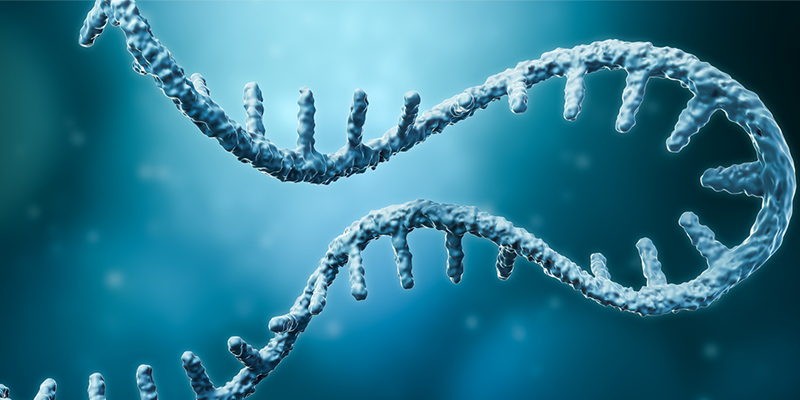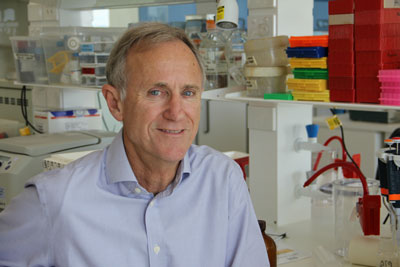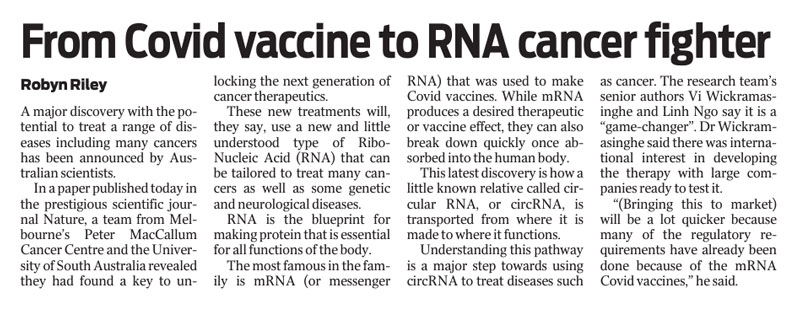Discovery could lead to new RNA-therapeutics for many cancers
 HEALTH A team from the Centre for Cancer Biology at UniSA and SA Pathology, and the Peter MacCallum Cancer Centre in Melbourne have identified the pathway of circRNA that could help to overcome a significant drawback of existing mRNA-based therapeutics.
HEALTH A team from the Centre for Cancer Biology at UniSA and SA Pathology, and the Peter MacCallum Cancer Centre in Melbourne have identified the pathway of circRNA that could help to overcome a significant drawback of existing mRNA-based therapeutics.Australian scientists have made a major discovery in better understanding how circular RNA molecules work, opening the possibility of new treatments for cancer.
A team from the Centre for Cancer Biology at UniSA and SA Pathology, and the Peter MacCallum Cancer Centre in Melbourne, have identified the pathway of circRNA that could help to overcome a significant drawback of existing mRNA-based therapeutics.
The discovery, reported in the prestigious journal Nature, has the potential to advance cancer therapy through longer-lasting RNA-based drugs with a wider array of uses.
 UniSA/CCB Professor Greg Goodall, part of the team that made the landmark discovery.
UniSA/CCB Professor Greg Goodall, part of the team that made the landmark discovery.Head of the Gene Regulation Laboratory at the Centre for Cancer Biology, Professor Greg Goodall, collaborated with Peter Mac scientists Dr Vi Wickramasinghe and Linh Ngo on the research.
The scientists say better understanding the pathway of circular RNA molecules is comparable to the profound impact that nanotechnology advances in Messenger RNA (mRNA) have had on vaccine development.
Currently, breakthrough therapeutics utilise mRNA – injectable genetic material that produces a desired therapeutic or vaccine effect – but they can also break down quickly once absorbed into the human body.
“It’s the linear shape of mRNA that makes it relatively unstable and lack durability inside the body and this has been a limiting factor in the potential application of RNA-based therapeutics for diseases such as cancer,” says Dr Wickramasinghe, senior author on the paper.
“For this reason, there’s a rising interest and excitement about another more robust form of RNA – known as circular or circRNA – which has the shape of a closed loop of genetic material, making it much more durable. However key features of how circRNA operates within cells has remained a mystery – until now.”
The scientists have discovered how circular RNAs, which are made in the nucleus of cells, are actively transported out of the nucleus to their site of action in the body of the cell (the “cytoplasm”). Understanding this pathway is a major step towards harnessing circRNA for therapeutic purposes, in much the same way as mRNA.
“Intriguingly, this mechanism resembles the way some proteins are transported out of the nucleus rather than the mechanisms employed to export other types of RNA,” Prof Goodall says.
“This further cements evidence these circular RNAs, of which there are many different types, are made to carry out important functions in the cell – a contention that has been unclear for most of the circular RNAs discovered to date.
“Now this molecular mechanism is worked out, it opens up possibilities for manipulating it for beneficial outcomes such as disease therapies.”
The research is a collaboration between the Peter Mac Callum Cancer Centre and the Centre for Cancer Biology at SA Pathology and UniSA, and was funded by the NHMRC, Victorian government agency veski, the Victorian Cancer Agency and National Breast Cancer Foundation (NBCF).
Dr Wickramasinghe says when this work began in 2017 it was “purely fundamental, blue sky discovery research” and years before the COVID pandemic would herald the arrival of the world’s first mRNA vaccines.
“No one could have predicted how mRNA-based therapeutics would change medicine, nor the tremendous potential for circRNAs in underpinning the next generation of RNA-based therapeutics,” Dr Wickramasinghe says.
The paper, titled “Nuclear export of circular RNA”, can be read in full in Nature.

Other Stories
- Invasive weed could be turned into a viable economic crop
- Discovery could lead to new RNA-therapeutics for many cancers
- Parents behaving badly: the impact on kids’ sport
- Can kimchi really help you lose weight? Hold your pickle. The evidence isn’t looking great
- From the Vice Chancellor: A question of culture
- Achievements and Announcements
- Immersive exhibition invites visitors to help mend a broken world
- Innovative urban living concept tackles housing woes and offers socially connected solutions
- Afghan refugees ‘transform and rejuvenate’ Port Adelaide LGA
- The latest books from UniSA researchers




